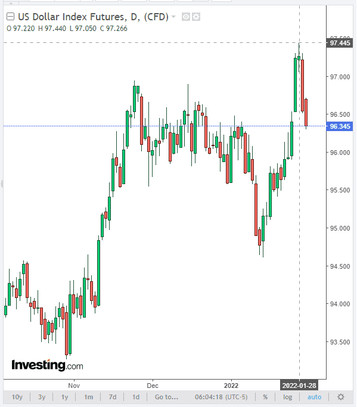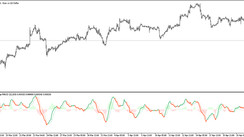At the end of today's meeting, the leaders of the Reserve Bank of Australia left the key rate at a record low level of 0.10%, also saying that they do not intend to raise interest rates until inflation stabilizes in the target range of 2%-3%, but acknowledging that the economy works much better than they expected.
However, market participants expect the RBA to raise rates this spring, while some other major global central banks have already signaled their inclination to tighten monetary policy to counter the biggest inflationary threat to the global economy since the 1980s.
The Fed announced this at its December meeting. Federal Reserve Bank of Kansas City President and FOMC member Esther George recently confirmed that the current monetary policy in the US is not in line with the fast growing economy and needs to be adjusted. "With inflation close to its highest level in 40 years, strong demand momentum, multiple signs and evidence of supply shortages amid strong labor market demand, the current very loose monetary policy is not in line with the economic outlook", George said on Monday.
Now market participants are preparing for summing up the results of the meetings of the European Central Bank and the Bank of England, which will be held on Thursday, February 3. Market participants do not expect that at this meeting the ECB will make cardinal decisions, believing that the central bank will continue to take a wait-and-see attitude, perhaps even until the end of 2022.
The data released last Friday reflected a sharp contraction in Germany's GDP in the 4th quarter of 2021 (by -0.7% after an increase of +1.7% in the 3rd quarter and against the forecast of -0.3%). In annual terms, the growth rate of the German economy slowed down from 2.8% to 1.4%. The business sentiment index in the Eurozone fell to 112.7 in January from 113.8 in December; business climate index in the services sector of the Eurozone in January also showed a decrease from 10.9 to 9.1 points, while in industry it fell from 14.6 to 13.9 points, with an increase forecast to 15 points. The German economy is the locomotive of the entire European economy, and its slowdown has a negative impact on the economy of the entire Eurozone. Thus, statistics on the dynamics of Eurozone GDP for the 4th quarter of 2021, published on Monday, indicated its slowdown (from 2.3% to 0.3%).
As Eurostat reported today, the unemployment rate in the Eurozone in December was 7.0% against 7.1% in November (the forecast was 7.2%), and in Germany the unemployment rate in January fell to 5.1% from 5.2% in December. At the same time, ECB representatives have repeatedly stated earlier that in the United States the situation with the recovery of the labor market after the coronavirus pandemic is better, and inflation is higher than in the EU countries, which indicates the impossibility of comparing these economies.
A number of European countries have recently introduced new restrictions due to covid. Restrictive measures and consumer caution are reflected in the weakening PMI index for the Eurozone services sector. This indicator, published last week, was 51.2 against the forecast of 52.2 and 53.1 in December.
It would be difficult for ECB leaders to ease monetary policy after all the measures taken during the pandemic, but it is all the more premature to talk about tightening it, economists say. If the ECB raises already fairly high inflation forecasts for 2023 and 2024, this could indicate an acceleration in the rollback of asset purchases. But the market, by and large, already takes into account this scenario in euro quotes.
Meanwhile, as we can see from the EUR/USD daily chart, the pair is rising for the second day in a row today. At the time of publication of this article, EUR/USD is traded just below today's local and intraday high of 1.1268, developing an upward trend.
However, this growth is mainly due to the weakening of the dollar, which can be seen from the dynamics of other major dollar currency pairs, where these currencies, the main competitors of the dollar, are strengthening against it. The DXY dollar index is also declining today for the second day in a row after hitting a new local high since August 2020 at 97.44 last week.

As you know, last Wednesday the meeting of the Fed ended, and the rhetoric of its head Powell was distinguished by toughness regarding the prospects for the monetary policy of the central bank. Powell said there is room to raise rates without hurting the labor market. According to him, "there is significant room for raising rates without jeopardizing the labor market", as "labor market conditions correspond to full employment". At the same time, the situation with inflation in the United States worsened after the December Fed meeting, Powell acknowledged, stating that "Fed policy will need to respond in the event of a further deterioration in the situation".
Recall that the ECB meeting will end on Thursday with the publication at 12:45 (GMT) of the decision on interest rates. At 13:30, the ECB press conference will begin, which will be of major interest to market participants. In its course, a surge in volatility is possible not only in euro quotes, but also in the entire financial market, if ECB leaders make unexpected statements. The soft tone of statements will have a negative impact on the euro. And, on the contrary, the tough tone of the speech of the ECB management regarding the monetary policy of the central bank will strengthen the euro.





